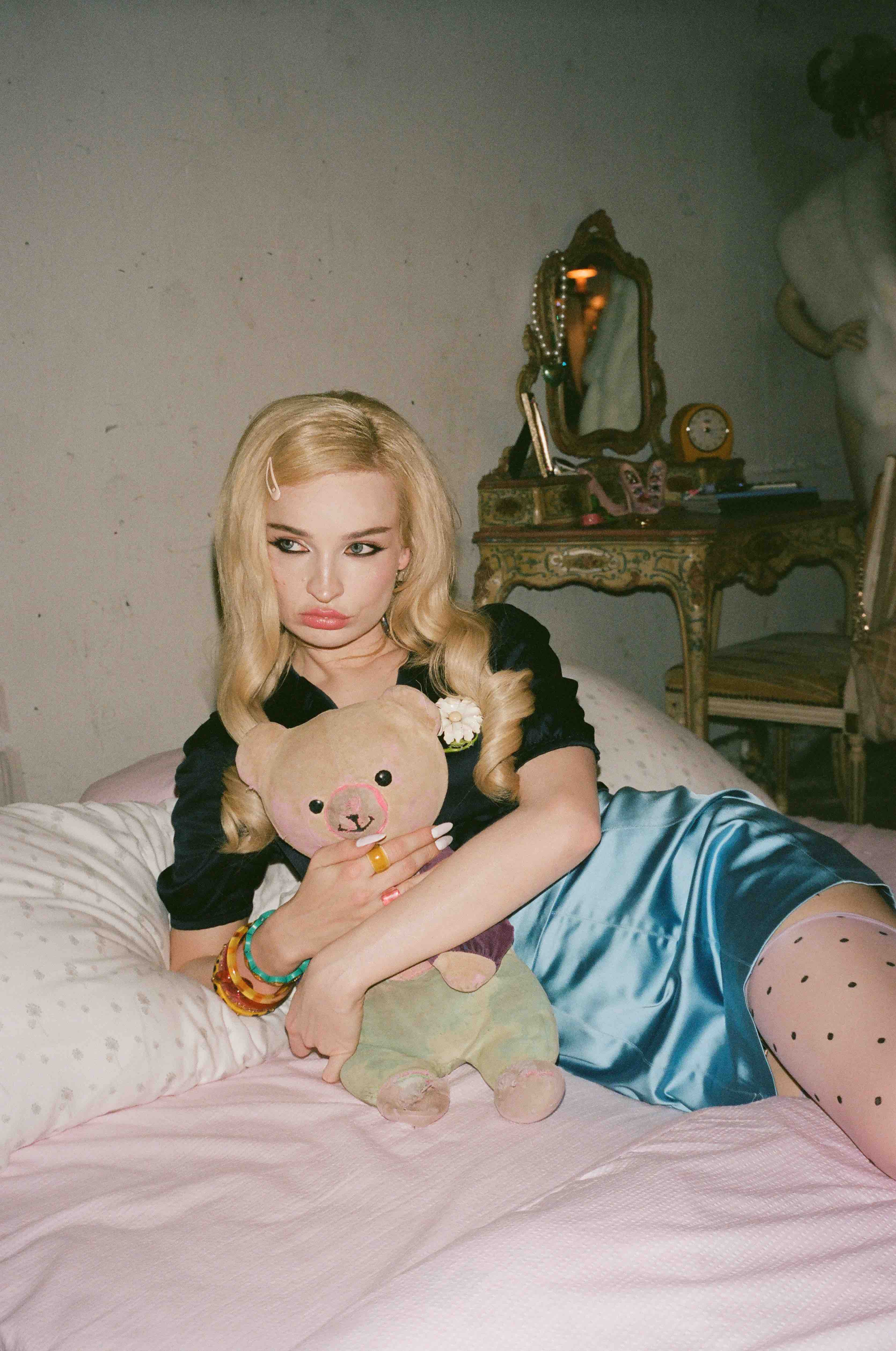

[**THOM BROWNE**](https://www.thombrowne.com/us) jacket, shirt, shorts, shoes, socks, and garter. [**THOM BROWNE**](https://www.thombrowne.com/us) jacket, shirt, pants, shoes, and socks.
As the 1990’s came to an end, Jeremiah “Terminator” LeRoy released his first novel, Sarah, a semi-autobiographical tale of drugs, sex, and abuse through a journey westward from West Virginia to California. The novel, followed by two others were later discovered to be written by a woman, and though throughout history, authors have often written under pseudonyms, the American public of the early 2000’s was not willing to let a woman’s manifest destiny make a profit off what the New York Times at the time called, “one of the most bizarre literary mysteries in recent memory” (Warren St. John, 2006).
The biggest literary hoax of modern times is brought to life with Justin Kelly’s re-imagining of the JT LeRoy story, through the POV of Savannah Knoop, sister-in-law of Laura Albert, writer and creator of the fabricated personality, JT LeRoy. Based on the memoir _Girl Boy Girl: How I Became JT LeRoy_, Kelly and Knoop work tirelessly to present a telegenic tale of pre-social media sensationalism in a world not ready to accept that what we see and what we read are not always truth, and that what makes a good story may not be what you expect.
After the film closed the 43rd Toronto International Film Festival, it followed a string of premieres and festival appearances including the Flaunt celebrated world premier of _J.T. LeRoy_, from Universal Pictures, in Hollywood this April, and will be available on Netflix in 2020. With the films revival comes old conversations about gender identity, politics, and artistic representation. As the cast of misfits work together to bring to life the awkward yet, strangely relatable story of JT, the cinematography and character study Kelly brings forth feels different and new. Here, we have the story of Knoop illuminated through Kristen Stewart’s portrayal, and audiences can finally start to answer, _why anyone would say yes to such a farce._ The compelling and perilous 6-year adventure of how Knoop got from point A, to point Q and the family entanglement unravels with Laura Dern’s eccentric portrayal of Laura Albert.
As someone watching this film today, it can sometimes be hard to imagine why the phenomenon of JT LeRoy could have upset so many people. Fiction writers are under no obligation to give truth, fact, or testimony, and yet because it is the written word, many believe in the power of ‘text’ as something which is holy. The effects and affects of what we read can be altered by the knowledge of ‘Truth’, but does that let us dismiss fiction as less powerful?
Throughout Kelly’s film, I get a sense that these characters and their moments are something we all experience daily; hiding who we are in order to create something bigger than ourselves. Wigs, gender bending, family strife, sexual confusion & exploration, mental health, and discovering who you are only after big mistakes; this is a story which relates to audiences more than we might be ready to admit.
Kelly meets me at our Los Angeles Flaunt location, while Knoop joins us via phone from New York to dissect and discuss the reasons why so many viewers are horrified by the mystification of fact & fiction, fame & fortune, and just a touch of drag.
* * *


[**THOM BROWNE**](https://www.thombrowne.com/us) jacket, shirt, pants, shoes, and socks.
**I want to talk about the film, but also get a feel for what was going on during the 1990’s, and thinking about sexism and politics. If the JT LeRoy phenomenon occurred today, would it have been less sensationalism?**
Knoop: This question comes up often, there is no way to really know. We are in a phase of thinking of identity as multifaceted and ever changing. We see role switching now as sort of accepted thing in the mainstream, not in more alternative thinking. I think it brings up questions of representation. It will always matter to people that a specific experience affects the way we filter the world. The mainstream media filters through the hegemonic gaze, down on white men, etc. It's a testament to the fact that the themes in the film are relevant now, at this moment. The material is relevant; gender and its new phase. The headlines happening then in _The New York Time_s were, “he's a she”. No one would use that language now.
**I agree, I was reading a quote by Lena Dunham where she was speaking about the JT LeRoy situation, “This person isn't who they claim to be but they still wrote the book that captured all our imaginations” To think about all this, people will always think about the representation.**
Knoop: If you like a book for its content then it’s sealed within itself, and should not be affected by who wrote it.
**There are so many writers who use pseudonyms, many of which are male. Do you think gender matters to this situation? Is it about the pseudonym or more, and is it possible to pull off again?**
Knoop: It does matter, yet it doesn't. It all depends. It's interesting how horrified people got, so much outrage, that you wonder why.
Kelly: That’s a multi-layered question. In terms of social media, it would be more difficult to pull off this sort of disguise. Something JT-esque all over again could happen but the way it was pulled of, physically, would be so difficult.
Knoop: When we went out as JT, the wig, ect, it was purported to be a wig. We always made it very clear that JT was in a disguise and part of his persona was about a disguise and another part was about withholding. I think this type of character is relevant to today.


[**THOM BROWNE**](https://www.thombrowne.com/us) jacket, shirt, and pants.
**Part of social media is creating a facade, it's very metatheatrical. In that vain, Justin, did you feel that you were adding a current perspective when you were recreating this story?**
Kelly: This film was different from the others because those earlier works were more documentary style, revealing information and exposing. But, this one came about after reading Savannah’s memoir. People wrote it off as someone desiring fame and fortune, but I was inspired. Over time, topics about queer identity and gender identity have become more relevant and impacted some scenes in the film but we didn’t change anything in order to appeal to the cultural climate.
Knoop: When we watched the film with the general public at the premiere in SF, I remember there was a scene where JT says, “I'm not here to make you feel comfortable” and I think people feel this move today in 2019. People can say, “Okay this is where we’re at.” I don't think Justin updated it to fit in with the times, but there are sentient moments.
**Do you feel as if you captured or gave a good perspective of the depression going on with Laura at the time. This began as a writing expression, rather than something done for fame. Do you feel you captured the psychology of it all?**
Kelly: It’s tricky because, I don't think Laura would say she wrote this all because she was depressed. She was in a depressed state, but that JT the character was actually depressed and wrote through Laura. When she wrote as JT, he embodied her and she him. Had she merely written fiction with a pseudonym, like JK Rowling, then maybe I would say that the JT LeRoy story was a way to expel depression. But, in this case Laura saw JT as real, so it wasn't a way for her to escape depression. We provide true data and facts in the film, and I feel its correctly represented.
**Is there some aspect of the process of making this film that you want the audience to take away?**
Knoop: I think that Justin specifically told the story from the Sav point of view, and if it gets into the space of Laura’s story, it's done so with respect.
Kelly: We felt confident after ten years of working on this script and playing with different versions, that the most interesting story was the six years in which Savannah was JT LeRoy, but, through Savannah’s perspective. The how's and the why's. Those who want more details can watch the documentary.
I think of answers I've had to give about the end message, but much like my films, I don't make them with the idea of a final message or moral. However, if there were any take away or theme, It would be about starting a conversation about gender and identity and finding one's true self.
Knoop: I think Justin has this amazing way of laying out the facts and the emotions, then the emotional facts which sort of overlay. I think Justin has an even hand in telling, and directing. One goal is for the audience to decide for themselves about these overarching themes of ethics, gender, identity, and decide for themselves. We are not trying to explain or lecture or defend. The feminism of the piece is having these two “women” characters, and the power dynamics of them working as JT LeRoy, but not a cat fight. They are collaborators. The logic working in the characters is that everyone is involved in the story and what to take away is up to them.
* * *
Photographed by [Stephanie Dimiskovski](https://www.instagram.com/stephdimiskovski/?hl=en)
 
[**THOM BROWNE**](https://www.thombrowne.com/us) jacket, shirt, shorts, shoes, socks, and garter. [**THOM BROWNE**](https://www.thombrowne.com/us) jacket, shirt, pants, shoes, and socks.
As the 1990’s came to an end, Jeremiah “Terminator” LeRoy released his first novel, Sarah, a semi-autobiographical tale of drugs, sex, and abuse through a journey westward from West Virginia to California. The novel, followed by two others were later discovered to be written by a woman, and though throughout history, authors have often written under pseudonyms, the American public of the early 2000’s was not willing to let a woman’s manifest destiny make a profit off what the New York Times at the time called, “one of the most bizarre literary mysteries in recent memory” (Warren St. John, 2006).
The biggest literary hoax of modern times is brought to life with Justin Kelly’s re-imagining of the JT LeRoy story, through the POV of Savannah Knoop, sister-in-law of Laura Albert, writer and creator of the fabricated personality, JT LeRoy. Based on the memoir _Girl Boy Girl: How I Became JT LeRoy_, Kelly and Knoop work tirelessly to present a telegenic tale of pre-social media sensationalism in a world not ready to accept that what we see and what we read are not always truth, and that what makes a good story may not be what you expect.
After the film closed the 43rd Toronto International Film Festival, it followed a string of premieres and festival appearances including the Flaunt celebrated world premier of _J.T. LeRoy_, from Universal Pictures, in Hollywood this April, and will be available on Netflix in 2020. With the films revival comes old conversations about gender identity, politics, and artistic representation. As the cast of misfits work together to bring to life the awkward yet, strangely relatable story of JT, the cinematography and character study Kelly brings forth feels different and new. Here, we have the story of Knoop illuminated through Kristen Stewart’s portrayal, and audiences can finally start to answer, _why anyone would say yes to such a farce._ The compelling and perilous 6-year adventure of how Knoop got from point A, to point Q and the family entanglement unravels with Laura Dern’s eccentric portrayal of Laura Albert.
As someone watching this film today, it can sometimes be hard to imagine why the phenomenon of JT LeRoy could have upset so many people. Fiction writers are under no obligation to give truth, fact, or testimony, and yet because it is the written word, many believe in the power of ‘text’ as something which is holy. The effects and affects of what we read can be altered by the knowledge of ‘Truth’, but does that let us dismiss fiction as less powerful?
Throughout Kelly’s film, I get a sense that these characters and their moments are something we all experience daily; hiding who we are in order to create something bigger than ourselves. Wigs, gender bending, family strife, sexual confusion & exploration, mental health, and discovering who you are only after big mistakes; this is a story which relates to audiences more than we might be ready to admit.
Kelly meets me at our Los Angeles Flaunt location, while Knoop joins us via phone from New York to dissect and discuss the reasons why so many viewers are horrified by the mystification of fact & fiction, fame & fortune, and just a touch of drag.
* * *

[**THOM BROWNE**](https://www.thombrowne.com/us) jacket, shirt, shorts, shoes, socks, and garter. [**THOM BROWNE**](https://www.thombrowne.com/us) jacket, shirt, pants, shoes, and socks.
As the 1990’s came to an end, Jeremiah “Terminator” LeRoy released his first novel, Sarah, a semi-autobiographical tale of drugs, sex, and abuse through a journey westward from West Virginia to California. The novel, followed by two others were later discovered to be written by a woman, and though throughout history, authors have often written under pseudonyms, the American public of the early 2000’s was not willing to let a woman’s manifest destiny make a profit off what the New York Times at the time called, “one of the most bizarre literary mysteries in recent memory” (Warren St. John, 2006).
The biggest literary hoax of modern times is brought to life with Justin Kelly’s re-imagining of the JT LeRoy story, through the POV of Savannah Knoop, sister-in-law of Laura Albert, writer and creator of the fabricated personality, JT LeRoy. Based on the memoir _Girl Boy Girl: How I Became JT LeRoy_, Kelly and Knoop work tirelessly to present a telegenic tale of pre-social media sensationalism in a world not ready to accept that what we see and what we read are not always truth, and that what makes a good story may not be what you expect.
After the film closed the 43rd Toronto International Film Festival, it followed a string of premieres and festival appearances including the Flaunt celebrated world premier of _J.T. LeRoy_, from Universal Pictures, in Hollywood this April, and will be available on Netflix in 2020. With the films revival comes old conversations about gender identity, politics, and artistic representation. As the cast of misfits work together to bring to life the awkward yet, strangely relatable story of JT, the cinematography and character study Kelly brings forth feels different and new. Here, we have the story of Knoop illuminated through Kristen Stewart’s portrayal, and audiences can finally start to answer, _why anyone would say yes to such a farce._ The compelling and perilous 6-year adventure of how Knoop got from point A, to point Q and the family entanglement unravels with Laura Dern’s eccentric portrayal of Laura Albert.
As someone watching this film today, it can sometimes be hard to imagine why the phenomenon of JT LeRoy could have upset so many people. Fiction writers are under no obligation to give truth, fact, or testimony, and yet because it is the written word, many believe in the power of ‘text’ as something which is holy. The effects and affects of what we read can be altered by the knowledge of ‘Truth’, but does that let us dismiss fiction as less powerful?
Throughout Kelly’s film, I get a sense that these characters and their moments are something we all experience daily; hiding who we are in order to create something bigger than ourselves. Wigs, gender bending, family strife, sexual confusion & exploration, mental health, and discovering who you are only after big mistakes; this is a story which relates to audiences more than we might be ready to admit.
Kelly meets me at our Los Angeles Flaunt location, while Knoop joins us via phone from New York to dissect and discuss the reasons why so many viewers are horrified by the mystification of fact & fiction, fame & fortune, and just a touch of drag.
* * *
 
[**THOM BROWNE**](https://www.thombrowne.com/us) jacket, shirt, pants, shoes, and socks.
**I want to talk about the film, but also get a feel for what was going on during the 1990’s, and thinking about sexism and politics. If the JT LeRoy phenomenon occurred today, would it have been less sensationalism?**
Knoop: This question comes up often, there is no way to really know. We are in a phase of thinking of identity as multifaceted and ever changing. We see role switching now as sort of accepted thing in the mainstream, not in more alternative thinking. I think it brings up questions of representation. It will always matter to people that a specific experience affects the way we filter the world. The mainstream media filters through the hegemonic gaze, down on white men, etc. It's a testament to the fact that the themes in the film are relevant now, at this moment. The material is relevant; gender and its new phase. The headlines happening then in _The New York Time_s were, “he's a she”. No one would use that language now.
**I agree, I was reading a quote by Lena Dunham where she was speaking about the JT LeRoy situation, “This person isn't who they claim to be but they still wrote the book that captured all our imaginations” To think about all this, people will always think about the representation.**
Knoop: If you like a book for its content then it’s sealed within itself, and should not be affected by who wrote it.
**There are so many writers who use pseudonyms, many of which are male. Do you think gender matters to this situation? Is it about the pseudonym or more, and is it possible to pull off again?**
Knoop: It does matter, yet it doesn't. It all depends. It's interesting how horrified people got, so much outrage, that you wonder why.
Kelly: That’s a multi-layered question. In terms of social media, it would be more difficult to pull off this sort of disguise. Something JT-esque all over again could happen but the way it was pulled of, physically, would be so difficult.
Knoop: When we went out as JT, the wig, ect, it was purported to be a wig. We always made it very clear that JT was in a disguise and part of his persona was about a disguise and another part was about withholding. I think this type of character is relevant to today.

[**THOM BROWNE**](https://www.thombrowne.com/us) jacket, shirt, pants, shoes, and socks.
**I want to talk about the film, but also get a feel for what was going on during the 1990’s, and thinking about sexism and politics. If the JT LeRoy phenomenon occurred today, would it have been less sensationalism?**
Knoop: This question comes up often, there is no way to really know. We are in a phase of thinking of identity as multifaceted and ever changing. We see role switching now as sort of accepted thing in the mainstream, not in more alternative thinking. I think it brings up questions of representation. It will always matter to people that a specific experience affects the way we filter the world. The mainstream media filters through the hegemonic gaze, down on white men, etc. It's a testament to the fact that the themes in the film are relevant now, at this moment. The material is relevant; gender and its new phase. The headlines happening then in _The New York Time_s were, “he's a she”. No one would use that language now.
**I agree, I was reading a quote by Lena Dunham where she was speaking about the JT LeRoy situation, “This person isn't who they claim to be but they still wrote the book that captured all our imaginations” To think about all this, people will always think about the representation.**
Knoop: If you like a book for its content then it’s sealed within itself, and should not be affected by who wrote it.
**There are so many writers who use pseudonyms, many of which are male. Do you think gender matters to this situation? Is it about the pseudonym or more, and is it possible to pull off again?**
Knoop: It does matter, yet it doesn't. It all depends. It's interesting how horrified people got, so much outrage, that you wonder why.
Kelly: That’s a multi-layered question. In terms of social media, it would be more difficult to pull off this sort of disguise. Something JT-esque all over again could happen but the way it was pulled of, physically, would be so difficult.
Knoop: When we went out as JT, the wig, ect, it was purported to be a wig. We always made it very clear that JT was in a disguise and part of his persona was about a disguise and another part was about withholding. I think this type of character is relevant to today.
 
[**THOM BROWNE**](https://www.thombrowne.com/us) jacket, shirt, and pants.
**Part of social media is creating a facade, it's very metatheatrical. In that vain, Justin, did you feel that you were adding a current perspective when you were recreating this story?**
Kelly: This film was different from the others because those earlier works were more documentary style, revealing information and exposing. But, this one came about after reading Savannah’s memoir. People wrote it off as someone desiring fame and fortune, but I was inspired. Over time, topics about queer identity and gender identity have become more relevant and impacted some scenes in the film but we didn’t change anything in order to appeal to the cultural climate.
Knoop: When we watched the film with the general public at the premiere in SF, I remember there was a scene where JT says, “I'm not here to make you feel comfortable” and I think people feel this move today in 2019. People can say, “Okay this is where we’re at.” I don't think Justin updated it to fit in with the times, but there are sentient moments.
**Do you feel as if you captured or gave a good perspective of the depression going on with Laura at the time. This began as a writing expression, rather than something done for fame. Do you feel you captured the psychology of it all?**
Kelly: It’s tricky because, I don't think Laura would say she wrote this all because she was depressed. She was in a depressed state, but that JT the character was actually depressed and wrote through Laura. When she wrote as JT, he embodied her and she him. Had she merely written fiction with a pseudonym, like JK Rowling, then maybe I would say that the JT LeRoy story was a way to expel depression. But, in this case Laura saw JT as real, so it wasn't a way for her to escape depression. We provide true data and facts in the film, and I feel its correctly represented.
**Is there some aspect of the process of making this film that you want the audience to take away?**
Knoop: I think that Justin specifically told the story from the Sav point of view, and if it gets into the space of Laura’s story, it's done so with respect.
Kelly: We felt confident after ten years of working on this script and playing with different versions, that the most interesting story was the six years in which Savannah was JT LeRoy, but, through Savannah’s perspective. The how's and the why's. Those who want more details can watch the documentary.
I think of answers I've had to give about the end message, but much like my films, I don't make them with the idea of a final message or moral. However, if there were any take away or theme, It would be about starting a conversation about gender and identity and finding one's true self.
Knoop: I think Justin has this amazing way of laying out the facts and the emotions, then the emotional facts which sort of overlay. I think Justin has an even hand in telling, and directing. One goal is for the audience to decide for themselves about these overarching themes of ethics, gender, identity, and decide for themselves. We are not trying to explain or lecture or defend. The feminism of the piece is having these two “women” characters, and the power dynamics of them working as JT LeRoy, but not a cat fight. They are collaborators. The logic working in the characters is that everyone is involved in the story and what to take away is up to them.
* * *
Photographed by [Stephanie Dimiskovski](https://www.instagram.com/stephdimiskovski/?hl=en)

[**THOM BROWNE**](https://www.thombrowne.com/us) jacket, shirt, and pants.
**Part of social media is creating a facade, it's very metatheatrical. In that vain, Justin, did you feel that you were adding a current perspective when you were recreating this story?**
Kelly: This film was different from the others because those earlier works were more documentary style, revealing information and exposing. But, this one came about after reading Savannah’s memoir. People wrote it off as someone desiring fame and fortune, but I was inspired. Over time, topics about queer identity and gender identity have become more relevant and impacted some scenes in the film but we didn’t change anything in order to appeal to the cultural climate.
Knoop: When we watched the film with the general public at the premiere in SF, I remember there was a scene where JT says, “I'm not here to make you feel comfortable” and I think people feel this move today in 2019. People can say, “Okay this is where we’re at.” I don't think Justin updated it to fit in with the times, but there are sentient moments.
**Do you feel as if you captured or gave a good perspective of the depression going on with Laura at the time. This began as a writing expression, rather than something done for fame. Do you feel you captured the psychology of it all?**
Kelly: It’s tricky because, I don't think Laura would say she wrote this all because she was depressed. She was in a depressed state, but that JT the character was actually depressed and wrote through Laura. When she wrote as JT, he embodied her and she him. Had she merely written fiction with a pseudonym, like JK Rowling, then maybe I would say that the JT LeRoy story was a way to expel depression. But, in this case Laura saw JT as real, so it wasn't a way for her to escape depression. We provide true data and facts in the film, and I feel its correctly represented.
**Is there some aspect of the process of making this film that you want the audience to take away?**
Knoop: I think that Justin specifically told the story from the Sav point of view, and if it gets into the space of Laura’s story, it's done so with respect.
Kelly: We felt confident after ten years of working on this script and playing with different versions, that the most interesting story was the six years in which Savannah was JT LeRoy, but, through Savannah’s perspective. The how's and the why's. Those who want more details can watch the documentary.
I think of answers I've had to give about the end message, but much like my films, I don't make them with the idea of a final message or moral. However, if there were any take away or theme, It would be about starting a conversation about gender and identity and finding one's true self.
Knoop: I think Justin has this amazing way of laying out the facts and the emotions, then the emotional facts which sort of overlay. I think Justin has an even hand in telling, and directing. One goal is for the audience to decide for themselves about these overarching themes of ethics, gender, identity, and decide for themselves. We are not trying to explain or lecture or defend. The feminism of the piece is having these two “women” characters, and the power dynamics of them working as JT LeRoy, but not a cat fight. They are collaborators. The logic working in the characters is that everyone is involved in the story and what to take away is up to them.
* * *
Photographed by [Stephanie Dimiskovski](https://www.instagram.com/stephdimiskovski/?hl=en)


















